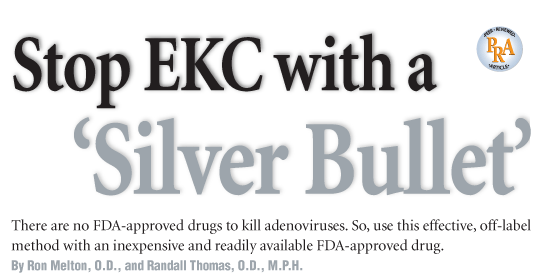
A 32-year-old white female presented to her optometrist with swollen lids, itchy red eyes and watery discharge. She complained of pain and severe foreign-body sensation.
She explained that her problem had started about a week earlier, when she felt itchiness in her left eye, which appeared to be inflamed. Her eye doctor presumed it was ocular allergy and prescribed Alrex (loteprednol etabonate 0.2%, Bausch & Lomb) q.i.d.
But, two days later, the discomfort had increased, and conjunctival injection was apparent near the caruncle. She was put on more aggressive therapy: Lotemax (loteprednol etabonate 0.5%, Bausch & Lomb) q2h for one day, then q.i.d. for one day. During these two days, the entire eye and eyelids became red and swollen, with crustiness upon waking. After another three or four days, the eye became much worse: it was nearly swollen shut, with watery discharge and severe foreign-body sensation. She also complained of flu-like symptoms: swollen glands, fever and headache.
Upon examination, her left eye had formed pseudomembranes under the upper lid, which would re-form rapidly after removal. Palpation for preauricular lymph nodes was positive. Her optometrist diagnosed her with classic adenoviral conjunctivitisspecifically, severe epidemic keratoconjunctivitis (EKC).
This patient was in extreme discomfort and needed immediate help. But, if the steroid didnt do the trick, what would?
Heres a silver bullet (though off-label) remedy: Kill the adenovirus with a few drops of 5% Betadine Sterile Ophthalmic Prep Solution (povidone/iodine, Alcon), followed by saline lavage.
Two days after Betadine treatment, this patients eye was pain-free and nearly back to normal.
In this article, well explain the pathophysiology of viral eye infection, suggest how to nail the diagnosis, and provide a step-by-step explanation of this highly effective, inexpensive, patient-friendly silver bullet EKC treatment.
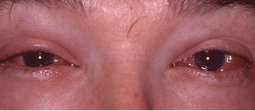
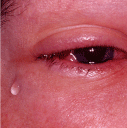
When this patient presented with severe epidemic keratoconjunctivitis, he had the classic signs of acute onset red eye (above) and watery discharge (left). Two days after Betadine treatment, his eyes were nearly white and quiet (below).
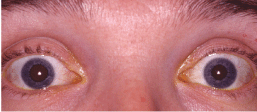
Viral Eye Disease
Viral eye disease is largely represented on three major fronts: herpes simplex disease, varicella zoster disease and adenoviral infections.
Lets look at each in turn.
Herpes simplex. Herpes simplex viruses (HSV) are responsible for nearly 50,000 new and recurring cases of HSV keratitis each year in the United States.1 HSV almost exclusively manifests as dendritiform or geographic epithelial keratitis.
Fortunately, we have a tried-and-true, FDA-approved medicine to kill the herpes simplex virus, available both generically as trifluridine 0.1% ophthalmic solution and by its original brand name of Viroptic (Monarch Pharmaceuticals).
Treatment is usually straightforward: one drop to the affected eye every two hours (while awake) for four to five days, then q.i.d. for four or five more days, depending upon the individual response. Preservative-free artificial tears are the only other eye drops that might be helpful in conjunction with this topical approach.
Then again, many doctors now bypass topical therapy and simply initiate therapy with an oral antiviral, such as 400mg of oral acyclovir five times a day for one week or Valtrex (valacyclovir, GlaxoSmithKline) 500mg t.i.d. for one week.
Varicella zoster (herpes zoster). The varicella zoster virus (VZV) causes chicken pox in children. As immunity wanes over the years, the VZV reactivates and causes shingles. The most common site is around the trunk of the body, but the second most common site is the ophthalmic (or first) division of the trigeminal nerve.
Regardless of site, the treatment is uniform: 800mg p.o. of oral acyclovir five times a day for one week. Alternatively, the equivalent dosage of Valtrex is 1,000mg p.o. t.i.d. for one week, or Famvir (famciclovir, Novartis) 500mg p.o. t.i.d. for one week.
The eye itself is involved in approximately half of all ophthalmic division cases. If the eye is involved, it is always an expression of inflammation, and often can be quickly controlled with the aggressive use of a potent corticosteroid, such as Lotemax or Pred Forte (prednisolone acetate 1%, Allergan), dosed q2h for a few days, then tapered over two to three weeks.
Adenoviral infections. Adenoviral infection manifests predominantly as epidemic keratoconjunctivitis (EKC). EKC is diagnosed as an acute onset red eye with watery discharge. It typically begins in one eye, and the fellow eye becomes afflicted in two or three days. The cornea is generally clear, and there are petechial hemorrhages seen on the bulbar conjunctiva, especially superiorly. In our experience, there is almost always a palpable ipsilateral lymphadenopathy. However, one study has shown that lymphadenopathy is present nearly 44% of the time.2
When the fellow eye becomes involved, it is usually about half as expressed as the initial eye. For this reason, we often treat only the initially affected eye.
Silver Bullet Protocol
There are no FDA-approved medicines to kill adenoviruses. But, an excellent off-label application of an FDA-approved drug is readily and inexpensively available: 5% Betadine Sterile Ophthalmic Prep Solution.
Off-Label Use of Ophthalmic Medications Dont hesitate to choose an off-label therapy when appropriate and necessary. Remember, the practice of ophthalmic off-label drug use is neither uncommon nor new, writes Richard K. Parrish II, M.D., of Bascom Palmer Eye Institute, and Paul Sternberg, Jr., M.D., of the Vanderbilt Eye Institute. In some cases, the off-label use of medications has become the widely accepted standard of care. Parrish R 2nd, Sternberg P Jr. Does off-label mean off limits for patient care? Am J Ophthalmol 2007 May;143(5):853-5.
This is a diluted form of the same solution (10% Betadine) that surgeons use prior to gloving when scrubbing in for surgery. It is widely used as a presurgical prep solution for cataract and other ophthalmic surgical procedures, and has even been shown to be safe and effective in neonatal ocular prophylaxis in labor and delivery suites. Yet, it is woefully underutilized in eye care. (See Off-Label Use of Ophthalmic Medications.)
They add, Treatment with any drug or therapy is based on a consensus between a well-informed patient and physician. This is no different in the case of the use of off-label ophthalmic medications. The more scientifically sound the information supporting its use, the more confidently can the physician and patient assess the possible value of the proposed unapproved treatment.
Lastly, they point out that the Ophthalmic Mutual Insurance Company recognizes that off-label use of approved medications is a legal and necessary part of the practice of medicine.
There is no question whatsoever in my mind that this [5% povidone-iodine treatment] technique deserves wider dissemination, and indeed, the occurrence of the serious sequelae (pseudomembrane formation, nummular keratitis, etc.) are greatly reduced, to say nothing of the much more rapid clinical resolution and effective way to reduce further viral spread, says fellowship-trained corneal subspecialist Izak Wessels, M.D., of Chattanooga, Tenn.3
Subepithelial infiltrates, legendary in the literature of EKC, can be avoided by radically shortening the viral residence time on the ocular surface. The Betadine therapy precludes enough viral antigen from gaining access into the anterior stroma to evoke an immune response, as evidenced by the prevention of subepithelial infiltration. This further enhances patient care and preserves visual function.
By the same token, patients with EKC are highly infectious by direct physical contact as long as they have a watery discharge. The Betadine treatment significantly truncates the infectious period. We urge you to consider this treatment for your patients who present with acute, highly symptomatic EKC.
Heres the protocol:
First, rule out any allergy or sensitivity to iodine (the molecular backbone of Betadine).
Betadine stings upon instillation, so anesthetize the eye with 0.5% proparacaine.
Instill one or two drops of an NSAID, as Betadine can cause mild stippling to the corneal epithelium.
Instill four to five drops of Betadine 5% Ophthalmic Prep Solution.
Have the patient gently close his or her eyes and roll the eyes around to fully expose all the conjunctival surfaces.
With the patients eye closed, use either your gloved finger or a cotton swab moistened with Betadine, and rub along the eyelid margins to eradicate any resident virus there.
After 60 seconds, lavage the ocular tissues with sterile saline irrigation solution. At this point, the viral load has been largely cleared from the ocular tissues; however, the conjunctiva remains red and injected as a result of pre-treatment, adenoviral-induced inflammation. So, we always prescribe Lotemax q.i.d. for four or five days to hasten tissue renormalization and enhance patient comfort.
Instill a couple of drops of NSAID in the office prior to discharging the patient, just to maximize patient comfort. Occasionally, a mild, transient superficial punctate keratitis (SPK) can result from such treatment, and the NSAID is simply an optional step to minimize any patient discomfort. We usually schedule a follow-up visit in three or four days.
Between the two of us, we have used this procedure more than 200 times and find it enormously helpful for our patients with acute EKC. We hope all eye doctors will immediately embrace this therapeutic modality, as it represents a major advance in helping patients with adenoviral infection.
However, if the patient has been acutely symptomatic for more than five or six days, we usually dont treat with Betadine because EKC likely resolves on its own in seven to 10 days. If the patient delays seeking care, we may still prescribe Lotemax q.i.d. for a few days to help with the discomfort.
In-Office Test Pins Down Pink Eye Not all clinical presentations yield a quick and certain diagnosis. This can be especially true in differentiating the acute red eye. The RPS Adeno Detector, an in-office culture for adenovirus (top), shows positive results in minutes (bottom).
While EKC is certainly a primary infection, it can create impressive secondary inflammation, which explains why steroids can be a very beneficial adjunctive treatment. A study of almost 2,000 patients at Bascom Palmer Eye Institute showed that 5% of clinically diagnosed cases of HSV were really adenovirus, and 4.8% of clinically diagnosed cases of adenovirus were really HSV.4 This is a sound reason to do a culture to confirm the diagnosis. (See In-Office Test Pins Down Pink Eye.)
Fortunately, a relatively new technology can give significant refinement to the differential diagnosis. Rapid Pathogen Screening (www.rps-tests.com) makes the RPS Adeno Detector, a simple, quick, inexpensive, in-office culture kit that tests for the presence of adenoviral serotypes. It is highly sensitive and specific, and can be very helpful in determining whether the conjunctivitis is of adenoviral origin.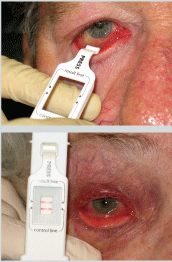
Remember that EKC almost exclusively afflicts adults. Much less often encountered are the less virulent serotypes that generally afflict children with a constellation of low-grade fever, mild sore throat and conjunctivitis. This condition is very aptly named pharyngoconjunctival fever (PCF).
EKC and PCF are treated differently. Our usual treatment for PCF is simply cool compresses, artificial tears, occasionally vasoconstrictors, and, if needed, Alrex q.i.d. for four to six days. Thankfully, most of these young patients generally have a rather uneventful course and do well. Because PCF is a much less virulent expression, we have never seen the need to treat with Betadine.
There are safe and highly effective drugs available to treat viral eye diseases: 5% ophthalmic Betadine for EKC, trifluridine (or oral antivirals) for epithelial herpes simplex, and oral antivirals for shingles and/or chicken pox. When properly applied, these drugs bring patients rapid relief.
Drs. Melton and Thomas lecture extensively on eye disease and ocular pharmacology. They are the authors of Review of Optometrys Clinical Guide to Ophthalmic Drugs. They have no financial interest in 5% Betadine or the RPS Adeno Detector.
1. Liesegang TJ. Herpes simplex virus epidemiology and ocular importance. Cornea 2001 Jan;20(1):1-13.
2. Uchio E, Takeuchi S, Itoh N, et al. Clinical and epidemiological features of acute follicular conjunctivitis with special reference to that caused by herpes simplex virus type 1. Br J Ophthalmol 2000 Sep;84(9):968-72.
3. Personal e-mail communication with Izak Wessels, M.D.
4. Marangon FB, Miller D, Alfonso E. Laboratory results in ocular viral diseases: implications in clinical-laboratory correlation. Arq Bras Oftalmol 2007 Mar-Apr;70(2):189-94.

